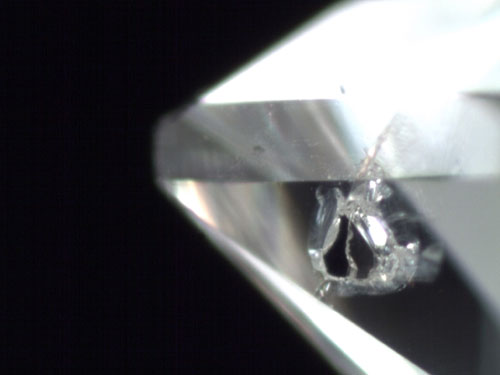A knot is a specific type of inclusion found within diamonds. It refers to an included crystal or foreign material that is embedded within the diamond, and in certain cases, it extends all the way to the surface of the stone, disrupting the clarity of the diamond. The knot can sometimes result in a visible raised or burnt area on the diamond’s surface, which may affect both the diamond’s appearance and its overall value.
Formation and Characteristics of a Knot
A knot is formed when a crystal or a foreign material becomes trapped within the diamond during its crystallization process. These inclusions are often caused by other minerals, such as garnet, graphite, or pyrite, which can become incorporated into the diamond’s crystal structure as it forms deep within the Earth’s mantle. These inclusions, when they grow to a size large enough and reach the surface of the diamond, are identified as knots.
The key characteristics of a knot include:
Size: Knots can vary in size, but they are generally larger than many other types of inclusions.
Shape: A knot is often irregularly shaped, with rough edges that can be visible within the diamond.
Visibility: When a knot reaches the surface, it may be visible to the naked eye or under magnification, depending on its size and location.
Effect of a Knot on Diamond Clarity
Inclusions, including knots, are important factors in determining the clarity grade of a diamond. The presence of a knot can significantly reduce a diamond’s clarity, depending on its size, location, and visibility. Since clarity is one of the key factors in diamond grading, knots are generally considered undesirable, especially if they are prominent or affect the overall appearance of the diamond.
The primary impacts of a knot on clarity are:
Lower Clarity Grade: Knots are typically graded as part of the diamond’s clarity assessment. A diamond with a visible knot on the surface may be downgraded in clarity compared to a similar diamond with fewer inclusions or no knots.
Potential for Weakening the Diamond: While knots do not always affect a diamond’s durability, they can sometimes create weak points. If a knot is close to the surface, it may potentially make the diamond more susceptible to damage, such as chipping or cracking.
Visual Appearance of a Knot
When a knot breaks through the surface of the diamond, it can sometimes leave a visible mark, which could be a slightly raised area or a burnt-looking spot. These marks can appear darker or different in texture than the surrounding surface of the diamond. In some cases, knots may appear as small, black or dark spots, particularly if the included crystal is dark or opaque.
Since the surface of a diamond is a key aspect of its overall appearance, the presence of a knot can have an impact on how light interacts with the stone, potentially reducing its brilliance or sparkle. However, in some cases, the knot may be positioned in such a way that it does not significantly affect the diamond’s aesthetic quality.
Impact of Knots on Diamond Value
Knots can reduce a diamond’s market value, as they negatively affect its clarity and appearance. The extent of the impact on value depends on several factors:
Size of the Knot: Larger knots, particularly those visible to the naked eye, will generally result in a more significant reduction in value.
Location of the Knot: Knots located in more visible areas, such as the crown or table, will have a greater impact on the diamond’s appearance and thus its value. Conversely, knots located on the pavilion (bottom) or near the girdle may be less noticeable.
Number of Knots: Diamonds with multiple knots may be valued lower than those with fewer or no inclusions. However, some diamonds may contain one or two small knots that do not significantly affect their overall appearance or value.
Knot vs. Other Inclusions
While a knot is a relatively specific type of inclusion, it is useful to compare it with other types of diamond inclusions:
Crystal: Similar to a knot, a crystal is an inclusion of another mineral within the diamond. However, unlike a knot, a crystal does not necessarily break through the surface of the diamond.
Feather: A feather is another inclusion that can sometimes reach the surface of the diamond. Unlike knots, feathers are typically fissures or cracks in the diamond that may or may not affect the clarity grade.
Needle: A needle inclusion is a thin, elongated inclusion that does not typically reach the surface of the diamond, and thus may not be as impactful as a knot.
Treatment of Knots
In some cases, diamond cutters may attempt to minimise the visual impact of a knot by carefully positioning it or by using techniques like laser drilling to remove or reduce the visibility of inclusions. However, the presence of a knot often cannot be completely eliminated, particularly if the knot is close to the surface.
Additionally, some diamonds with prominent knots may be treated by laser inscription, which may help with traceability but will not alter the presence of the knot itself.

